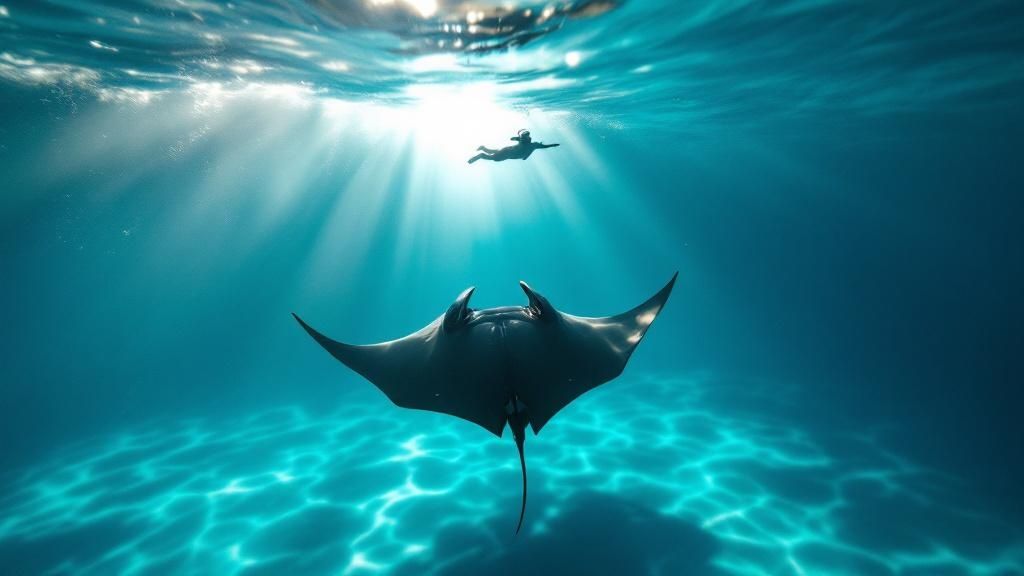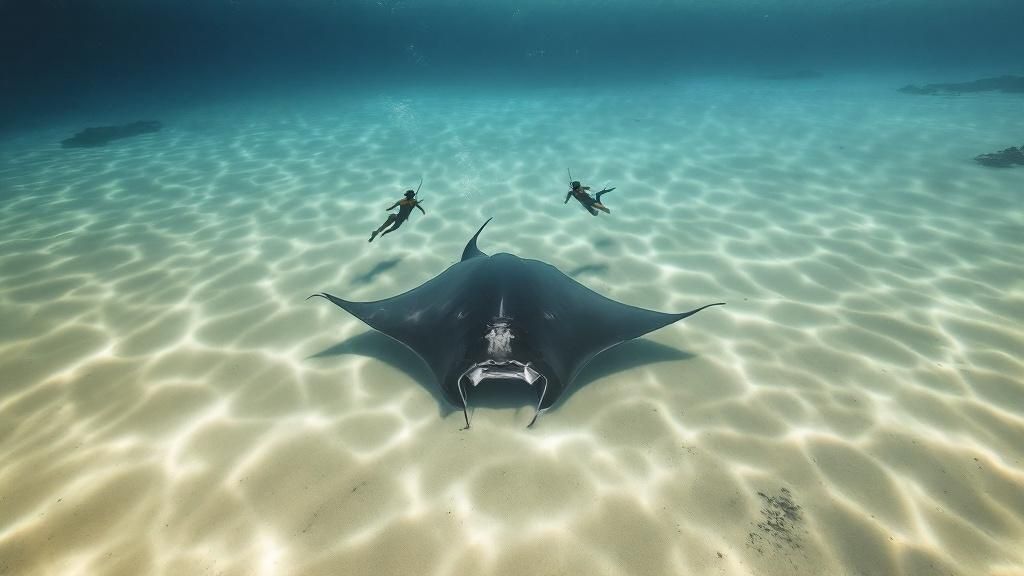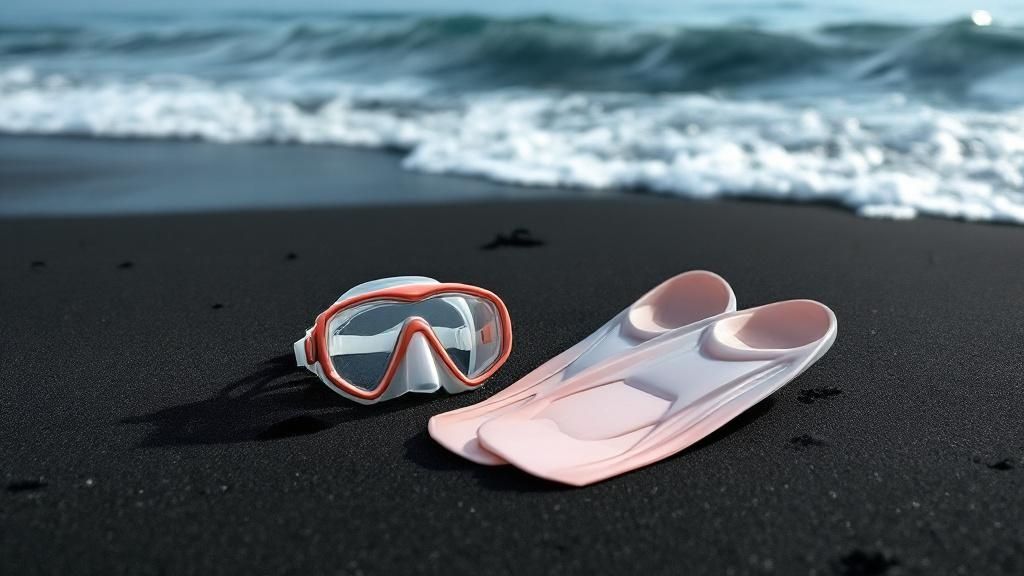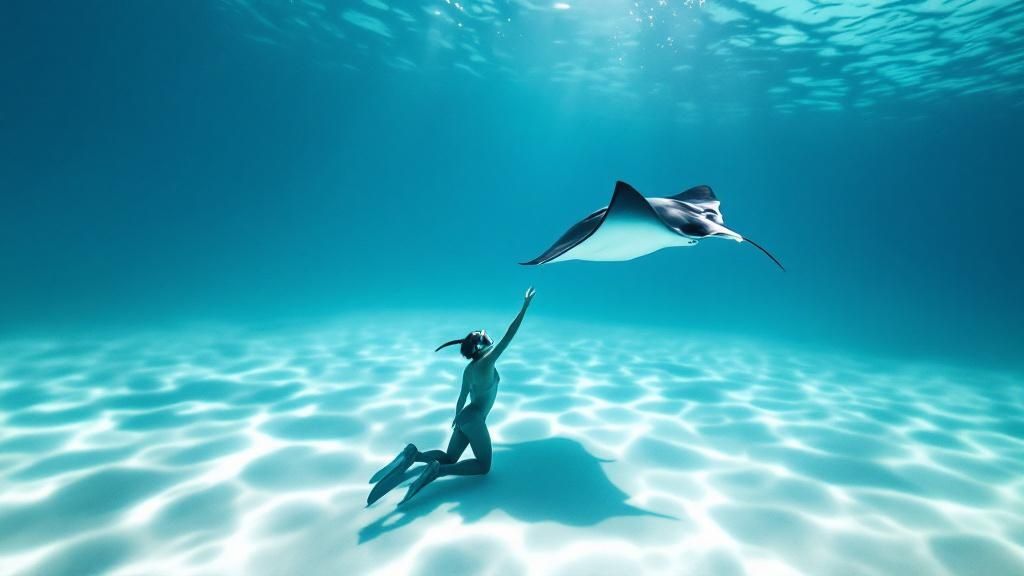Manta Ray Snorkel Big Island: Unforgettable Kona Night Adventure
- Byron
- Jul 24
- 12 min read
Imagine this: you're floating in the warm, dark Pacific waters just off the Big Island's Kona coast. Below you, massive manta rays with wingspans reaching up to 16 feet perform an otherworldly ballet, gliding and somersaulting through beams of light.
This isn't a scene from a documentary. It's the world-famous manta ray snorkel Big Island experience, a truly magical adventure that you can only find here in Hawaii. Think of this guide as your complete roadmap to making this unforgettable encounter happen.
Your Unforgettable Night with Gentle Giants
Exploring Hawaii's underwater world is always incredible, but the manta ray night snorkel is something else entirely. This isn't a lucky, once-in-a-lifetime sighting; it's a reliable and breathtaking spectacle that has put Kona on the map for ocean lovers across the globe. We'll get into exactly why this spot is the world's epicenter for this experience and what makes it an absolute must-do.
Don't just take my word for it. See what others are saying in the reviews below from top-rated companies like Manta Ray Night Snorkel Hawaii.
From getting to know these gentle giants to picking the right tour and knowing what to bring, we'll cover everything. My goal is to help you prepare for an adventure that you’ll be talking about for years to come.

The Kona Coast Manta Phenomenon
So, what makes Kona the best place on Earth for this? It all started by accident. Decades ago, a hotel on the coast installed bright lights that shined into the ocean. These lights attracted swarms of plankton, which, as it turns out, is a manta ray's favorite meal.
Before long, savvy local boat captains realized they could replicate this effect. By shining lights into the water, they created a reliable "dinner bell" for the mantas. It's a brilliant and simple setup that gives you a guaranteed front-row seat to one of nature's most elegant performances.
The local manta population here is incredibly well-studied and consistent. The Big Island is home to about 130 identified individual manta rays, including both the common reef manta (Mobula alfredi) and the much larger, rarer giant manta ray (Mobula birostris). Researchers can actually tell them apart by the unique spot patterns on their bellies—they're just like human fingerprints. You can dive deeper into some fascinating facts about the local manta population on the Kona Snorkel Trips blog.
The Manta Ray Night Snorkel is more than just a tour; it’s your chance to connect with a unique and thriving marine ecosystem, turning a simple swim into an extraordinary nighttime adventure.
The best part? This experience is accessible to almost everyone. You don't need to be an expert swimmer or a seasoned diver. Whether you're a first-time snorkeler or bringing the kids along, the tour companies have you covered. They provide all the gear to make it safe and comfortable:
Flotation Devices: You’ll hold onto a large, custom-built raft, so all you have to do is float and watch. No swimming is required.
Wetsuits: The Pacific can get a little chilly at night. A wetsuit keeps you warm and adds extra buoyancy.
Snorkel Gear: You’ll get a professionally fitted mask and snorkel, so your view of the show is crystal clear.
Ready to see it for yourself?
For more details on a trusted local operator that keeps groups small and puts safety first, you can visit the homepage of Manta Ray Night Snorkel Hawaii.
What to Expect on a Manta Ray Snorkel Tour
So, you're ready to snorkel with manta rays on the Big Island? Let's walk through what the experience is actually like. It's a brilliantly simple and almost magical setup that brings together tour boats, microscopic sea life, and the ocean's gentle giants. The whole thing kicks off with powerful underwater lights, which basically act as a giant dinner bell in the dark Pacific.
These lights shine down into the water, attracting huge swarms of plankton—tiny organisms that manta rays absolutely love to eat. For the mantas, this glowing cloud of plankton is an irresistible, all-you-can-eat buffet. As you float on the surface, you get a front-row seat to an incredible feeding frenzy, watching an underwater ballet unfold just inches below you.

The Stars of the Show
Along the Kona coast, you'll meet two different types of manta rays. Knowing who you're swimming with makes the whole experience even cooler.
Reef Manta (*Mobula alfredi*): These are the locals. They're the ones you're most likely to see, as they hang out in the coastal waters all year. While they can have wingspans up to 18 feet, the ones you’ll meet are typically around 12 feet across.
Giant Oceanic Manta (*Mobula birostris*): Seeing one of these is a rare and truly awe-inspiring treat. They are the largest rays in the world and only occasionally drop by the feeding sites.
Manta rays are incredibly smart, with the largest brain-to-body size ratio of any fish. More importantly, they are completely harmless. Unlike stingrays, mantas have no teeth, no stingers, and no barbs. Your encounter will be totally safe and peaceful. It's their gentle and curious nature that makes this snorkel such a profound way to connect with wildlife.
Witnessing the Manta Dance
The most captivating part of the night is watching the mantas feed. They don't just swim through the plankton; they perform these graceful, efficient maneuvers to scoop up as much food as possible.
You'll see them do mesmerizing barrel rolls, somersaulting over and over again through the plankton clouds. This isn't just for show—it's a highly effective feeding technique that has become a reliable and breathtaking spectacle for everyone watching from the surface.
This unique mix of natural instinct and learned behavior is what makes the Kona manta ray night snorkel one of the most unforgettable wildlife encounters in the world. When you join a tour, you’re stepping into a well-established and respectful relationship between people and nature.
Ready for your front-row seat to this incredible show?
Why the Kona Manta Population Is So Fragile
When you glide into the water for a manta ray night snorkel, you’re not just an observer—you’re a guest in a very special and isolated community. Understanding just how unique these animals are changes the experience entirely. It goes from being a cool vacation activity to a profound connection with a delicate ecosystem, and it drives home why responsible tourism is so vital for their future.
Think of the Kona manta population like a small, tight-knit village that has very little contact with the outside world. This isn’t just a cute analogy; it's backed by science. Recent genetic studies have confirmed that the manta rays around Hawaiʻi Island are genetically isolated from other populations. They are, in a very real sense, their own separate family. You can dive deeper into the science and explore the research findings here to see how this makes them so vulnerable.

The Impact of Isolation
What does this genetic isolation actually mean? It means there's very little new DNA coming into their gene pool. The mantas you see don't travel far, and they aren't mixing with other groups from across the ocean. They are true Kona locals, born and raised.
This creates a precarious situation. With low genetic diversity, the population is less equipped to handle big challenges like environmental changes or new diseases. A problem that might be a minor hiccup for a large, widespread species could have a devastating impact on this small group.
Because this "village" is so self-contained, every single manta ray is incredibly precious to the health of the entire community. It’s why their slow growth and late maturity also become such critical factors in their survival.
Because the Kona manta ray population is so contained, the loss of even a few individuals to local threats can have a disproportionately large impact on the entire community's future.
Local Threats with Big Consequences
This fragility makes Kona's mantas especially susceptible to localized dangers that might not seriously affect other marine populations. Unfortunately, these threats are almost all caused by human activity, which means we have a responsibility to be mindful.
The key dangers they face are:
Boat Strikes: Accidental collisions with boats can cause severe, often fatal, injuries.
Fishing Line Entanglement: Getting tangled in discarded fishing lines and nets is a huge problem, leading to injury, infection, and even drowning.
Understanding this vulnerability is everything. When you choose a responsible tour operator for your manta ray snorkel Big Island adventure, you're doing more than just booking a tour. You are actively participating in the protection of these magnificent animals. Good companies put the mantas' safety first, follow strict guidelines, and help build a sustainable tourism model that ensures these gentle giants will be here for generations to come.
How to Choose the Right Manta Snorkel Tour
With so many companies offering a manta ray snorkel Big Island tour, picking the right one can feel a little overwhelming. But it’s one of the most important decisions you’ll make—not just for your enjoyment and safety, but for the well-being of the mantas themselves. The trick is to find an operator that’s truly committed to responsible tourism.
A great starting point is to look for tour companies that operate by the "Manta Ray Green Listed" standards. While the official list isn't maintained anymore, the best operators still voluntarily follow these strict guidelines for conservation and safety. When you choose one of these companies, you know you’re supporting a business that puts the manta rays’ health above all else.

Key Factors to Consider
Beyond looking for a "green" operator, a few other details will help you find the perfect tour for your crew. Think about the boat size and how many other snorkelers will be with you. A larger boat usually means a more stable ride and more amenities like restrooms, which can be a game-changer for families. On the other hand, a smaller boat often delivers a more personal and adventurous feel.
Choosing a tour isn't just about price; it's about the quality of the experience, the company's commitment to safety, and its respect for the fragile marine environment you're about to enter.
Doing a little homework by reading recent reviews and asking questions before you book can make all the difference. Look for comments about the guides' knowledge, the thoroughness of the safety briefing, and how well they managed the group in the water. This little bit of research helps you pick a tour that's not just incredible, but also safe and respectful. For a deeper dive, check out this guide on the best manta ray snorkel tours and tips.
To help you visualize the options, here’s a quick comparison of the two main types of tour boats you’ll find in Kona.
Comparing Manta Ray Tour Types on the Big Island
Deciding between a large, stable vessel and a smaller, zippier raft really comes down to what kind of experience you're looking for. Each has its own distinct vibe.
Feature | Large Boat Tours | Small Boat / Raft Tours |
|---|---|---|
Capacity | 20-50+ passengers | 6-20 passengers |
Onboard Amenities | Often includes restrooms, snacks, and more space | Typically more basic amenities |
Experience | More stable ride, good for families or those prone to seasickness | Faster ride to the site, more intimate group setting |
Best For | Families with young children, non-swimmers, large groups | Adventurous couples, experienced snorkelers, small groups |
Ultimately, taking the time to select the right tour operator is what turns a simple activity into a truly meaningful adventure. With a bit of research, you can ensure your manta ray snorkel Big Island experience will be safe, responsible, and absolutely magical.
How to Prepare for Your Manta Snorkel Adventure
A little bit of prep work can be the difference between a good night and an absolutely unforgettable one on your manta ray snorkel Big Island tour. Think of this as your pre-flight checklist. Getting these few things sorted out beforehand means you can show up at the harbor relaxed, confident, and ready for the main event.
The great news is that any reputable tour company will handle all the important in-water gear. They’ll have you covered with good-quality masks, snorkels, wetsuits (which are key for staying warm!), and a custom flotation device. Your job is just to bring the personal stuff.
What to Bring and What to Expect
Packing a small bag with a few essentials will make your life a whole lot easier. You’ll be very happy you have these waiting for you on the boat after your swim.
Towel and a Change of Clothes: Trust me, you'll want to dry off and get into something cozy for the boat ride back to the harbor. A sweatshirt or even a light windbreaker is perfect.
Reusable Water Bottle: It’s easy to get a little dehydrated after being in the saltwater, so having some fresh water on hand is always a smart move.
Camera: If you have an underwater camera like a GoPro, bring it! This is the kind of magic you'll want to capture. If not, a regular camera is still great for snapping pictures on the boat.
On the day of the tour, try to have a light meal a couple of hours before you head out. It’s best to skip a big, heavy dinner right beforehand, as this can help you avoid feeling queasy once you’re on the water.
One of the best things about the manta ray night snorkel is just how accessible it is. You don't need to be a champion swimmer or a seasoned athlete to have an incredible time.
If you're not a strong swimmer or feel a bit nervous in the ocean, please don't let that stop you. The whole experience is designed with you in mind. You'll hold onto a big, very stable flotation board that has bright lights attached to it. This lets you float comfortably right on the surface—all you have to do is put your face in the water and watch the show unfold beneath you.
Plus, the guides are lifeguard-certified pros who are in the water with the group the entire time, making sure everyone feels safe and supported. For a more detailed look at what the tour involves, check out our [ultimate guide to the Big Island manta ray snorkel](https://www.mantaraynightsnorkelhawaii.com/post/manta-ray-snorkel-big-island-ultimate-guide-tips).
How to Snorkel with Manta Rays the Right Way
The Big Island's manta ray snorkel is one of the best examples of ecotourism in the world, and that’s not an accident. Its success hinges on everyone—from the tour operators to you, the snorkeler—doing their part. Think of it less like a tourist attraction and more like being a respectful guest in the mantas' home.
If you remember only one thing, make it this: never, ever touch a manta ray. They might look tough, but their skin is covered in a delicate mucus coating. This slime layer is their immune system, and touching them scrapes it off, leaving them wide open to dangerous infections. It's their invisible suit of armor, so admire it from a distance.
When you follow the rules, you help guarantee this incredible experience will be around for future generations to enjoy.
Following the Golden Rules
Any reputable tour company, especially those on the Manta Ray Green List, will walk you through these rules before you hit the water. Your job is surprisingly simple: just float. You're there to be a passive observer, letting the mantas do their thing.
Here are the key "dos and don'ts" for your manta ray snorkel Big Island adventure:
Observe, Don't Interact: Resist the urge to chase, grab, or "pet" a manta ray. Let them be wild.
Stay at the Surface: Don't dive down toward the mantas. The water column is their feeding zone, and you're just getting in the way.
Watch Your Fins: Keep your fins near the surface or pointed straight down. An accidental kick can injure a manta.
Let Them Come to You: Stay calm and still. The most breathtaking moments happen when a curious manta decides to get a closer look on its own terms.
Here’s something you might not know: when you book with a certified operator, you're actually helping with conservation. These companies report their sightings to researchers, providing crucial data that helps protect the local manta population and their home.
These guidelines are more than just friendly suggestions; they’re essential for protecting a very fragile ecosystem. Inshore manta rays already face threats from boat strikes and getting tangled in fishing lines. By snorkeling responsibly, you’re not just having an amazing time—you’re actively helping to reduce stress on these animals and support a tourism model that actually works.
To dive deeper, check out the fantastic conservation efforts for Hawaii's mantas and see how choosing the right tour makes a real impact.
Answering Your Questions About Manta Ray Snorkeling
It’s completely normal to have a few questions buzzing around your head before you dive into an adventure like this. I get it! Let's clear up some of the most common things people ask, so you can feel totally excited and ready for your manta ray snorkel Big Island tour.
We hear these questions all the time from our guests at Manta Ray Night Snorkel Hawaii, and putting your mind at ease is what we do best.
Is the Manta Ray Night Snorkel Safe?
Absolutely. When you go out with a professional, certified company, safety is the number one priority. Think of it this way: they handle all the serious stuff so you can focus on the magic. You’ll get top-notch flotation gear, clear safety instructions before you even touch the water, and lifeguard-certified guides right there with you the whole time.
And the mantas themselves? They're called "gentle giants" for a reason. They don’t have teeth, stingers, or barbs—they’re just peaceful filter-feeders, completely uninterested in bothering humans.
What if I'm Not a Strong Swimmer?
No problem at all! You actually don't need to be a swimmer to have an incredible time. In fact, you don’t really swim at all during the tour.
The secret is a big, custom-built flotation board. You just hold onto the handles and float comfortably on the surface while the show happens right below you. Plus, the wetsuit they give you makes you extra buoyant, so you feel totally secure in the water.
Are Manta Ray Sightings Guaranteed?
This is the amazing part. While we’re dealing with wild animals in their natural habitat, the Kona coast is one of the most reliable places on Earth to see them. The tour operators have been creating these underwater light fields for years, and the local mantas know it's a dependable spot for dinner. Success rates are consistently over 90%.
Because it's so reliable, many of the best companies offer a "manta guarantee." On the rare night the mantas don't show, you can go again on another night for free. It’s a pretty sweet deal.
What Is the Best Time of Year to Go?
I've got great news—there is no bad time! The manta ray snorkel is a year-round activity here on the Big Island. Our local manta population lives here permanently; they don't migrate, so you have a chance to see them any month of the year.
The ocean might be a little calmer in the summer, but incredible encounters happen every single night, year-round. The most important thing is simply picking a night with good weather. To get a better feel for it, check out our guide on the [top manta ray encounters on the Big Island](https://www.mantaraynightsnorkelhawaii.com/post/manta-ray-snorkeling-big-island-top-encounters).
Are you ready for your own otherworldly adventure with Kona's gentle giants? Book your tour with [Manta Ray Night Snorkel Hawaii](https://mantaraynightsnorkelhawaii.com/) for a safe, intimate, and unforgettable experience.